|
|
 |
Fiche d'espèce de Copépode |
|
|
Calanoida ( Ordre ) |
|
|
|
Arietelloidea ( Superfamille ) |
|
|
|
Augaptilidae ( Famille ) |
|
|
|
Haloptilus ( Genre ) |
|
|
| |
Haloptilus ornatus (Giesbrecht, 1892) (F,M) | |
| | | | | | | Syn.: | Hemicalanus ornatus Giesbrecht, 1892 (p.384, 399, 773, figs.F,M); Fish, 1962 (p.21) | | | | Ref.: | | | Giesbrecht & Schmeil, 1898 (p.120, Rem.F,M, fig.F); A. Scott, 1909 (p.141, Rem.); Wolfenden, 1911 (p.323); Sars, 1925 (p.247, figs.F); Sewell, 1932 (p.328); Rose, 1933 a (p.213, figs.F); Mori, 1937 (1964) (p.75, figs.F); Lysholm & al., 1945 (p.37); Sewell, 1947 (p.190, 194, fig.F); Chiba, 1956 (p.52, figs.M); Chiba & al., 1957 a (p.11); Grice, 1962 (p.223, figs.F); Tanaka, 1964 b (p.43, Rem.F); Vervoort, 1965 (p.126, Rem.); Owre & Foyo, 1967 (p.81, figs.F,M); Tanaka & Omori, 1971 (p.253, Rem.F); Matthews, 1972 (p.52); Björnberg & al., 1981 (p.653, 654, figs.F,M); Park, 1988 (p.14, Descr.F, figs.F, Rem.); Chihara & Murano, 1997 (p.728, Pl.58, 61: F,M); Bradford-Grieve & al., 1999 (p.883, 941, figs.F,M); Bradford-Grieve,1999 b (p.63, figs.F,M, Rem., figs.172, 190); Vives & Shmeleva, 2007 (p.244, figs.F,M, Rem.) |  issued from : J.M. Bradford-Grieve in The Marine Fauna of New Zealand: Pelagic Calanoid Copepoda. National Institute of Water and Atmospheric Research (NIWA). NIWA Biodiversity Memoir, 111, 1999. [p.63, Fig.34]. Female: A, habitus (dorsal); B, forehead (lateral right side); C, Mx1; D, Mx2; E, P5.
|
 issued from : T. Park in Antarct. Res. Ser. Washington, 1988, 47. [p.17, Fig.9]. Female: a, habitus (dorsal); b, forehead (lateral); c, idem (dorsal); d, urosome (dorsal); e, idem (lateral right side); f, genital segment (ventral); g, A2; h, Md; i, Md (cutting edge).
|
 issued from : T. Park in Antarct. Res. Ser. Washington, 1988, 47. [p.18, Fig.10]. Female: a, Mx1; b, Mx2; c, Mxp; d, P1 (anterior). Nota: A1 extending beyond distal end of caudal ramus by last 4 or 5 segments. Spermatheca more or less round when viewed laterally.
|
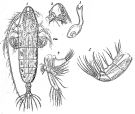 Issued from : G.O. Sars in Résult. Camp. Scient. Prince Albert I, 69, pls.1-127 (1924). [Pl.LXXIII, figs.1-5]. Female: 1, habitus (dorsal); 2, forehead (lateral); 3, Md; 4, Mx1; 5, Mx2.
|
 issued from : R.B.S. Sewell in The John Murray Expedition, 1933-34, Scientific Reports, VIII (1), 1947. [p.195, Fig.50, H]. Female (from Arabian Sea): H, Mx2.
|
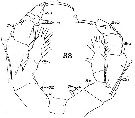 Issued from : W. Giesbrecht in Systematik und Faunistik der Pelagischen Copepoden des Golfes von Neapel und der angrenzenden Meeres-Abschnitte. – Fauna Flora Golf. Neapel, 1892. Atlas von 54 Tafeln. [Taf.27, Fig.38]. As Hemicalanus ornatus. Male: 38, P5 (posterior view). Ps = left leg; Pd = right leg; Re = exopod; Ri = endopod; Se = outer spine; Si = inner spine; St = terminal spine.
|
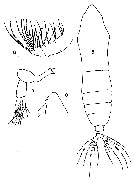 issued from : T. Mori in The pelagic Copepoda from the neighbouring waters of Japan, 1937 (2nd edit., 1964). [Pl.39, Figs.5-8]. Female: 5, habitus (dorsal); 6, Mx2; 7, Md; 8, forehead (lateral).
|
 Issued from : W. Giesbrecht in Systematik und Faunistik der Pelagischen Copepoden des Golfes von Neapel und der angrenzenden Meeres-Abschnitte. – Fauna Flora Golf. Neapel, 1892. Atlas von 54 Tafeln. [Taf.27, Figs.6, 7]. As Hemicalanus ornatus. Female: 6, Mx1 (posterior view); 7, Mx2 (postrior view).
|
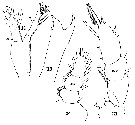 Issued from : W. Giesbrecht in Systematik und Faunistik der Pelagischen Copepoden des Golfes von Neapel und der angrenzenden Meeres-Abschnitte. – Fauna Flora Golf. Neapel, 1892. Atlas von 54 Tafeln. [Taf.27, Figs.14, 15, 21, 24]. As Hemicalanus ornatus. Female: 14, Md (mandibular palp); 15, Md (mandibular blade); 21, exopod of P5; 24, endopod of P3.
|
 issued from : G.D. Grice in Fish. Bull. Fish and Wildl. Ser., 1962, 61. [p.224, Pl.25, Figs.12-16]. Female (from 01°10'S, 134°57'W): 12, A2; 13, Md (biting edge); 14, Mx1; 15, Mx2; 16, P5.
|
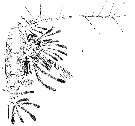 Issued from : W. Giesbrecht in Systematik und Faunistik der Pelagischen Copepoden des Golfes von Neapel und der angrenzenden Meeres-Abschnitte. – Fauna Flora Golf. Neapel, 1892. Atlas von 54 Tafeln. [Taf.42, Fig.1]. As Hemicalanus ornatus. Female: 1, habitus (dorsal).
|
 Issued from : W. Giesbrecht in Systematik und Faunistik der Pelagischen Copepoden des Golfes von Neapel und der angrenzenden Meeres-Abschnitte. – Fauna Flora Golf. Neapel, 1892. Atlas von 54 Tafeln. [Taf.42, Figs.17, 19, 22]. As Hemicalanus ornatus. Female: 17, exopodal segment 3 of P2; 19, urosome ( ventral); 22, endopod of A2.
|
 Issued from : W. Giesbrecht in Systematik und Faunistik der Pelagischen Copepoden des Golfes von Neapel und der angrenzenden Meeres-Abschnitte. – Fauna Flora Golf. Neapel, 1892. Atlas von 54 Tafeln. [Taf.42, Fig.9]. As Hemicalanus ornatus. Male: 9, habitus (dorsal).
|
 Issued from : W. Giesbrecht in Systematik und Faunistik der Pelagischen Copepoden des Golfes von Neapel und der angrenzenden Meeres-Abschnitte. – Fauna Flora Golf. Neapel, 1892. Atlas von 54 Tafeln. [Taf.42, Fig.24]. As Hemicalanus ornatus. Male: 24, endopod of A2.
|
 issued from : J.M. Bradford-Grieve, E.L. Markhaseva & C.E.F. Rocha & B. Abiahy in South Atlantic Zooplankton, Edit. D. Boltovskoy. 1999. Vol.2. Copepoda. [p.1043, Fig. 7.276]. Female: Mx1. Nota: Endopodite of Mx1 with 2 setae; exopodite with 10 setae; outer lobe 1 with 9 setae.
| | | | | Ref. compl.: | | | Wilson, 1942 a (p.189); Massuti Alzamora, 1942 (p.111); Sewell, 1948 (p.329, 504, 509, 522, 530, 532, 548, 558, 567); C.B. Wilson, 1950 (p.236); V.N. Greze, 1963 a (tabl.2); De Decker & Mombeck, 1964 (p.12); Grice & Hulsemann, 1965 (p.224); Furuhashi, 1966 a (p.295, vertical distribution in Kuroshio region, Table 9); Mazza, 1966 (p.72); Mullin, 1966 (p.546, Table I, III, diet); Furuhashi, 1966 a (p.295, vertical distribution in Oyashio/Kuroshio transitional area, Table 8); Fleminger, 1967 a (tabl.1); Delalo, 1968 (p.138, Rem.: ?); Morris, 1970 (p.2301); Park, 1970 (p.478); Deevey, 1971 (p.224); Bainbridge, 1972 (p.61, Appendix Table III: occurrence); Roe, 1972 (p.277, tabl.1, tabl.2); 1972 c (p.1032); Apostolopoulou, 1972 (p.328, 362); Deevey & Brooks, 1977 (p.156, tab.2, Station "S"); Carter, 1977 (1978) (p.36); Vives, 1982 (p.293); Kovalev & Shmeleva, 1982 (p.84); Cummings, 1984 (p.163, Table 2); Guangshan & Honglin, 1984 (p.118, tab.); Scotto di Carlo & al., 1984 (1044); Longhurst, 1985 (tab.2); Brenning, 1985 a (p.28, Table 2); 1986 (p.14, Rem.); Brinton & al., 1986 (p.228, Table 1); Chen Y.-Q., 1986 (p.205, Table 1: abundance %); Madhupratap & Haridas, 1986 (p.105, tab.1); Lozano Soldevilla & al., 1988 (p.60); Cervantes-Duarte & Hernandez-Trujillo, 1989 (tab.3); Heinrich, 1990 (p.18); Suarez & al., 1990 (tab.2); Madhupratap & Haridas, 1990 (p.305, fig.3: vertical distribution night/day; fig.7: cluster); Scotto di Carlo & al., 1991 (p.270) ; Suarez & Gasca, 1991 (tab.2); Hernandez-Trujillo, 1991 (1993) (tab.I); Suarez, 1992 (App.1); Shih & Young,1995 (p.68); Hure & Krsinic, 1998 (p.102); Alvarez-Cadena & al., 1998 (t.4); Padmavati & al., 1998 (p.347); Suarez-Morales & Gasca, 1998 a (p108); Lopez-Salgado & al., 2000 (tab.1); Fernandez-Alamo & al., 2000 (p.1139, Appendix); Holmes, 2001 (p.13); Vukanic, 2003 (p.139, tab.1); Hsiao & al., 2004 (p.325, tab.1) Lo & al., 2004 (p.89, tab.1); Zuo & al., 2006 (p.162: tab.1); Lavaniegos & Jiménez-Pérez, 2006 (Tab.2, 4, Rem.); Dur & al., 2007 (p.197, Table IV); Morales-Ramirez & Suarez-Morales, 2008 (p.518); Ayon & al., 2008 (p.238, Table 4: Peruvian samples); Williamson & McGowan, 2010 (p.273, Table 3, Pacific central gyres: N and S); Schnack-Schiel & al., 2010 (p.2064, Table 2: E Atlantic subtropical/tropical); Mazzocchi & Di Capua, 2010 (p.424); Hsiao S.H. & al., 2011 (p.475, Appendix I); Medellin-Mora & Navas S., 2010 (p.265, Tab. 2); in CalCOFI regional list (MDO, Nov. 2013; M. Ohman, comm. pers.); Lidvanov & al., 2013 (p.290, Table 2, % composition); Mazzocchi & al., 2014 (p.64, Table 5, abundance); Benedetti & al., 2016 (p.159, Table I, fig.1, functional characters); Benedetti & al., 2018 (p.1, Fig.2: ecological functional group); Belmonte, 2018 (p.273, Table I: Italian zones) | | | | NZ: | 15 | | |
|
Carte de distribution de Haloptilus ornatus par zones géographiques
|
| | | | | | | | | | | |  Issued from : M. Madhupratap & P. Haridas in J. Plankton Res., 12 (2). [p.310, Fig.3]. Issued from : M. Madhupratap & P. Haridas in J. Plankton Res., 12 (2). [p.310, Fig.3].
Vertical distribution of calanoid copepod (mean +1 SE), abundance No/100 m3. 7- Haloptilus ornatus.
Night: shaded, day: unshaded.
Samples collected from 6 stations located off Cochin (India), SE Arabian Sea, November 1983, with a Multiple Closing Plankton Net (mesh aperture 300 µm), in vertical hauls at 4 depth intervalls (0-200, 200-400, 400-600, 600-1000 m). |
| | | | Loc: | | | South Africa (E), SE Atlantic, G. of Guinea, off Lagos, off SW Ascension Is., off Trindade Is., off St . Paul Is. (SE & E), off Morocco-Mauritania, S Brazil, off Amazon, Barbada Is., Canary Is., Madeira, off Portugal, Azores, Caribbean Sea, Caribbean Colombia, Yucatan, Jamaica, G. of Mexico, Florida, Sargasso Sea, off Bermuda (Station "S"), off W Ireland, Medit. (Alboran Sea, NW Basin, Ligurian Sea, Napoli, Strait of Messina, Adriatic Sea, Ionian Sea, Aegean Sea, Lebanon Basin), G. of Akaba, Red Sea, Arabian Sea, Laccadive Is., off La Réunion Is., Natal, Indian (equatorial central & South), Indonesia-Malaysia, Philippines, China Seas (East China Sea, South China Sea), off Taiwan, Taiwan (SW, E, N: Mienhua Canyon), Japan (Izu), Bikini Is., California, W Baja California, Gulf of California, G. de Tehuantepec, off W Guatemala, W Costa Rica, Pacif. (tropical), off N Hawaii, W Costa Rica, SW Galapagos, off Peru, Pacif. (SE tropical), Pacific (central gyres: N and S), off Chile (33°S), Pacif. (W equatorial), off SW Australia, New Zealand (SW and SE North Island, N Tasman Sea) | | | | N: | 98 | | | | Lg.: | | | (1) F: 5; (11) F: 4,5-4,4; (16) F: 4,8-4,3; (46) F: 4,8-4,6; M: 3,05-2,75; (69) F: 4,54; (90) F: 4,94-2,88; (91) F: 5-3; (101) F: 4,56; (199) F: 5,09-4,1; M: 3,04-2,96; (785) F: 4; (866) F: 3-5,33; (909) F: 4,75; 4,95; (1108) F: 4,94; 5,17; {F: 2,88-5,33; M: 2,75-3,05} | | | | Rem.: | épi-mésopélagique.
Voir aussi les remarques en anglais | | | Dernière mise à jour : 07/12/2020 | |
|
|
 Toute utilisation de ce site pour une publication sera mentionnée avec la référence suivante : Toute utilisation de ce site pour une publication sera mentionnée avec la référence suivante :
Razouls C., Desreumaux N., Kouwenberg J. et de Bovée F., 2005-2025. - Biodiversité des Copépodes planctoniques marins (morphologie, répartition géographique et données biologiques). Sorbonne Université, CNRS. Disponible sur http://copepodes.obs-banyuls.fr [Accédé le 03 juillet 2025] © copyright 2005-2025 Sorbonne Université, CNRS
|
|
 |
 |



















